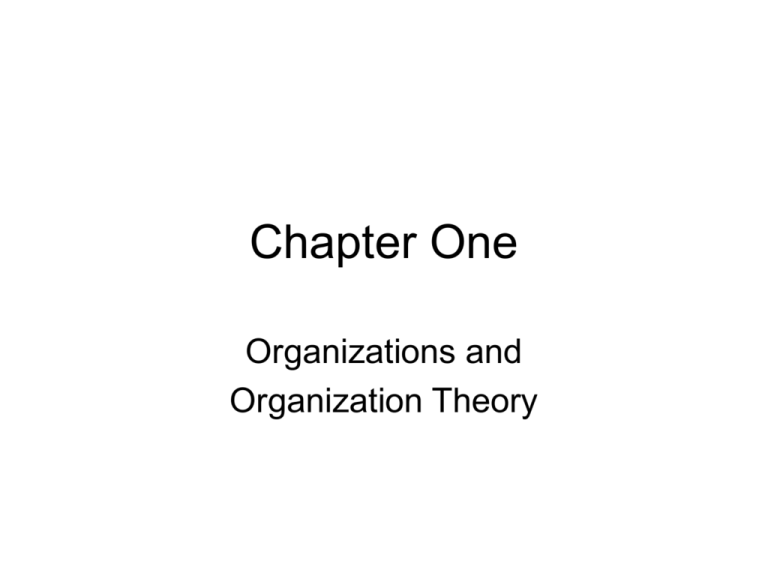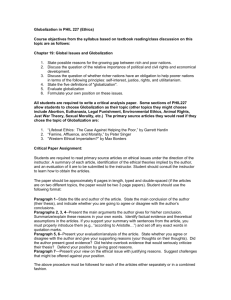Organization Theory in Action
advertisement

Chapter One Organizations and Organization Theory 1.Basic Concept Organizational Operations 管理行為 (Managerial Behavior) 管理系統 (Managerial System) People Activities 領導行為 (Leadership Behavior) Process 組織行為 (Organizational Behavior) 領 Leadership 導 Relationship between Leadership and organization Staffing Coordination Organization Control Planning 計 劃 R&D 行 Marketing 銷 發研 展究 人 事 Human Resource 財 務 Finance 生 Production 產 .Focus on Survive and growth Corporate Strategy Business Strategy .Focus on competitive advantage .Focus on functional efficiency Functional Strategy . Top-Down Directing . Bottom-Up Information . Involvement and Interaction Organizations and Organization Theory Topics • • • • • Organization Theory in Action What is an Organization? Perspectives on Organizations Dimensions of Organization Design The evolution of Organization Theory and Design Organization Theory in Action • Current Challenges – Globalization – Ethics and and Social Responsibility – Speed of Responsiveness – The Digital Workplace – Diversity Organization Theory in Action Globalization Current Challenge ‧通用汽車GM ‧North Networks ‧銳跑 Reebok ‧美國運通 American Express ‧三星 Samsung Organization Theory in Action Globalization ‧安隆(Enron) ‧世界通訊 (WorldCom) ‧Adelphia Co. ‧ImClone Co. Ethics and Social Responsibility Current Challenges Organization Theory in Action Globalization Ethics and Social Responsibility Current Challenge ‧皇家荷蘭殼牌 (Royal Dutch Shell) Speed of Responsiveness Organization Theory in Action Globalization Ethics and Social Responsibility Current Challenges ‧戴爾電腦(Dell Computer Co.) The Digital Workplace Speed of Responsiveness Organization Theory in Action ‧麥肯錫顧問公司 (McKinsey Co.) Globalization Ethics and Social Responsibility Diversity Current Challenges The Digital Workplace Speed of Responsiveness What is an Organization? Social Entities goal-directed Organization Deliberately structure & coordinated activity systems Linked to the external environment Importance of Organizations 1/7 1. Bring together resources to achieve desired goals & outcomes Builds nuclear-powered, Nimitz-class aircraft carriers Importance of Organizations 2/7 2. Produce goods and services efficiently. Electronic way to run company or base on computer produce skill. Importance of Organizations 3/7 3. Facilitate innovation To lead creation of new idea’s innovation but not to follow the rule. Importance of Organizations 4/7 4. Use modern manufacturing and information technologies Ex: Coca-Cola、Heineken、IBM ..etc. Importance of Organizations 5/7 5. Adapt to and influence a changing environment Importance of Organizations 6/7 6. Create value for owners, customers and employees Gallo company use low profit as its core strategy to create costumer value, and open system need to work with environment. Importance of Organizations 7/7 7. Accommodate ongoing challenge of diversity ethics, and the motivation and coordination of employees Perspectives on Organizations • Open Systems • Organizational Configuration – Technical Core – Technical Support – Administrative Support – Top Management – Middle Management An Open System and Its Subsystems Environment Raw Materials People Information resources Financial resources Subsystems Transformation Input Output Process Boundary Spanning Production, Maintenance, Adaptation, Management Boundary Spanning Products and Services 開放系統及其次系統 開放系統(open system)則必須與環境交互作用 能存活,一方面消耗環境的資源,一方面輸出 資源到環境中,並得持續地改變以適應環境。 Five Basic Parts of an Organization • Mintzberg suggested that every organization should contain five basic parts Transfer from input to output e.g teachers、 courses Top Management Technical Support Staff Middle Management Administrative Technical Core Exhibit 1.3 Five Basic Parts of an Organization Support Staff Five Basic Parts of an Organization Supporting organization to adopt environment. Ex.: engineer、researchers、etc. Top Management Technical Support Staff Middle Management Technical Core Administrative Support Staff Five Basic Parts of an Organization To support organization’s function stably and organization's maintain. Top Management Technical Support Staff Middle Management Technical Core Administrative Support Staff Five Basic Parts of an Organization To lead and negotiate other department in the organization. Top Management Technical Support Staff Middle Management Technical Core Administrative Support Staff Goals and Environment Strategy Size Culture Technology Structure 1. 2. 3. 4. 5. 6. Formalization Specialization Hierarchy of Authority Centralization Professionalism Personnel Ratios Characteristics of Three Organizations Formalization 100 Specialization 50 Centralization Configuration (%nonworkflow personnel) TECHNOLOGY SIZE (#employees) 0 W.L. Gore & Associates Manufacturing Wal-Mart 6,000 250,000 Retailing State Arts Agency Government Service 35 The Evolution of Organization Theory and Design • Historical Perspectives • Contemporary Organization Design • Effective Performance versus the Learning Organization Two Organization Design Approaches Natural System Design Mechanical System Design Vertical Structure Routine Tasks Formal Systems Horizontal Structure Rigid Culture Competitive Strategy Organizational Change in the Service of Performance Empowered Roles Shared Information Adaptive Culture Collaborative Strategy Stable Environment Turbulent Environment Efficient Performance Learning Organization Source: Adapted from David K. Hurst, Crisis and Renewal: Meeting the Challenge of Organizational Change (Boston, Mass.: Harvard Business School) Efficient performance and learning organization Vertical Structure Horizontal Structure Routine Tasks Empowered Roles Formal System Shared Information Competitive Strategy Collaborative Strategy Rigid culture Adaptive culture


